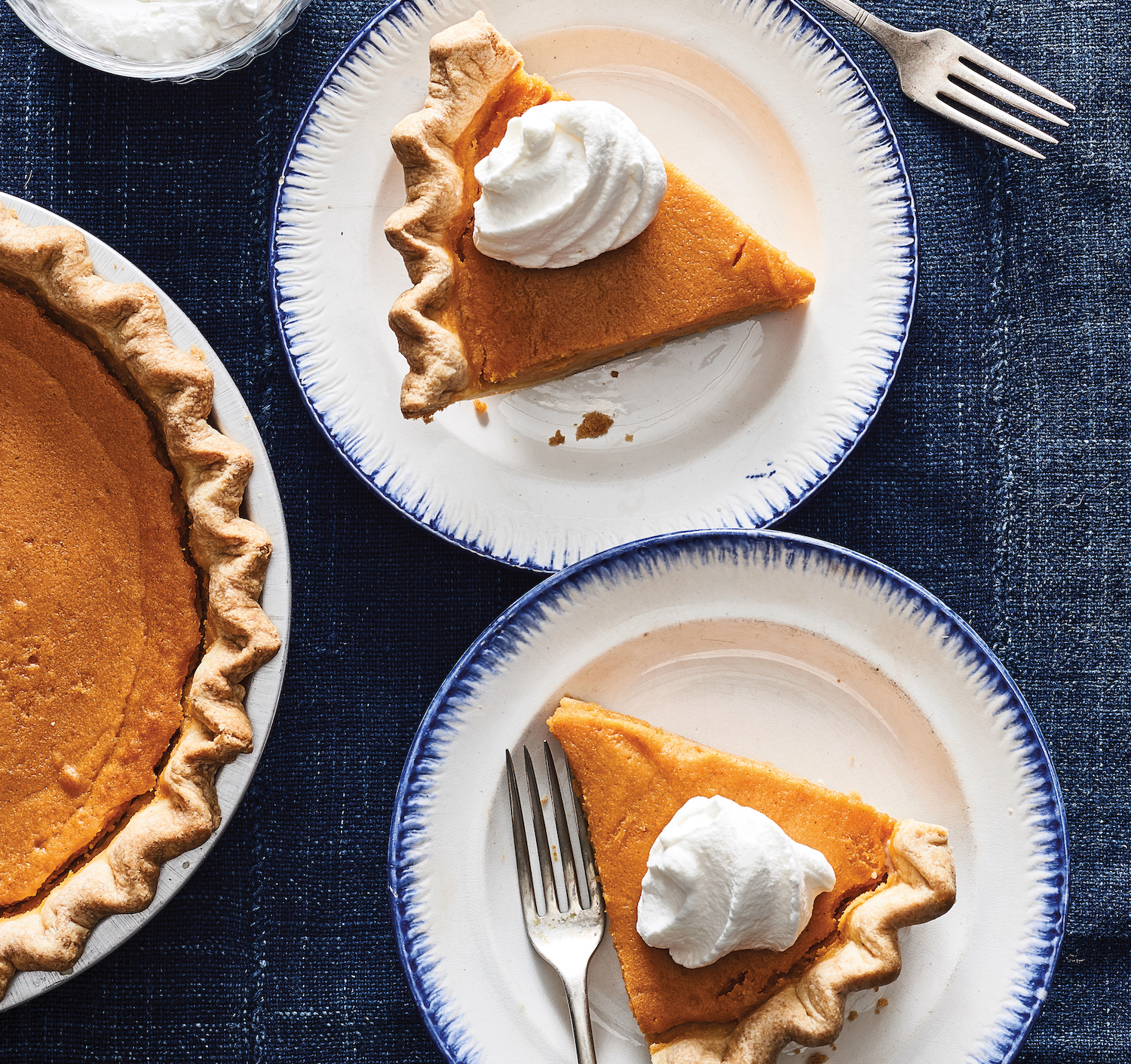My adoptive North Carolina ranks first in the nation in the production of sweet potatoes: more than 60,000 acres of them, about half of the total US production. In light of that, I came up with this recipe as a tribute to the farmers and their lovely sweet potatoes. Sweet potatoes have a wonderfully dense flesh and deep color that are in their full glory in this tasty pie.
Makes 8–10 servings
Old-Fashioned Shortening Pie Dough (see below) or another single-crust dough
Filling
3 medium-large sweet potatoes
3 large eggs plus 1 large egg yolk, at room temperature
⅔ cup packed light brown sugar
⅓ cup granulated sugar
4 tablespoons unsalted butter, melted
½c up heavy cream
½ cup half-and-half
¾ teaspoon vanilla extract
1 tablespoon all-purpose flour
½ teaspoon ground cinnamon
½ teaspoon ground nutmeg
¼ teaspoon ground cloves
½ teaspoon salt
whipped cream (optional)
1. Prepare and refrigerate the pie dough. Roll the dough into a 12 1/2- to 13-inch circle and line a 9- to 9 1/2-inch deep-dish pie pan with it, shaping the edge into an upstanding ridge. Flute or crimp the edge, chill the shell, and partially prebake it according to the instructions on page 000.
2. Preheat the oven to 400°F (200°C). Scrub the potatoes and place them on a baking sheet. Pierce them several times with a paring knife. Bake for 60 to 75 minutes, until they feel tender all the way through when pierced with a paring knife. Cut the potatoes open to help them cool faster.
3. When the potatoes have cooled, scoop the flesh into a food processor. Process to a smooth purée. Measure out 11/2 cups purée. (Save any extra purée for another use.)
4. Preheat the oven to 375°F (190°C). Whisk the eggs and egg yolk in a large bowl until frothy. Add the potato purée, sugars, melted butter, heavy cream, half-and-half, and vanilla. Using a handheld electric mixer, beat on medium-low speed until evenly blended. Mix the flour, cinnamon, nutmeg, cloves, and salt in a small bowl. Sprinkle over the liquid and blend it in on low speed.
5. Put the pie shell on a baking sheet, near the oven, and carefully pour the filling into the shell. Bake the pie, on the sheet, on the middle oven rack for 20 minutes. Reduce the heat to 350°F (180°C) and rotate the pie 180 degrees. Bake for 30 to 40 minutes longer, until the filling is set. When the pie is done, the filling will be wobbly and puff slightly around the edges.
6. Transfer the pie to a rack. Serve slightly warm, at room temperature, or chilled, garnished with whipped cream, if desired.
Boil or Bake?
In my sweet potato pie trials, I both boiled and baked the potatoes and found that I preferred the baked results. Baking takes longer, but it concentrates the flavor without adding excess moisture to the pie.
You get a creamier, fuller-bodied pie when the moisture comes from the cream and eggs. If you like, you can accelerate the pie-making process by baking the sweet potatoes the day before, perhaps when you have something else in the oven. Refrigerate them after they have cooled.
And by the way, since you’re baking sweet potatoes anyway, why not bake a couple of extras and use them to thicken soups or stews, or in muffins and quick breads. Or serve them as a simple side dish, mixed with butter and a drizzle of maple syrup.
Old-Fashioned Shortening Pie Dough
This is a pretty standard all-shortening piecrust, like the one my dad used when I was a youngster. A shortening piecrust won’t have the delicate flavor of a butter crust, and the texture is typically more crumbly, less flaky. Still, this yields a delicious, tender crust that many bakers believe makes the best pies.
One 9- to 91/2-inch standard or deep-dish pie shell
1½ cups all-purpose flour
1 tablespoon confectioners’ sugar (optional for a sweet pie; omit for a savory pie)
½ teaspoon salt
½ cup cold vegetable shortening
¼–⅓ cup cold water
1. Combine the flour, sugar (if using), and salt in a large bowl; refrigerate for 15 minutes.
2. Add the shortening to the dry ingredients and toss it with your hands to coat, then break it up into smaller pieces. Using a pastry blender, cut the shortening into the dry ingredients until the pieces of fat are roughly the size of small peas and everything looks like it has been touched by the fat. There should be no dry, floury areas.
3. Mound the ingredients in the center of the bowl. Drizzle about half of the water down the sides of the bowl, turning the bowl as you pour so the water doesn’t end up in one spot. Using a large fork, lightly mix the dough, tossing it from the perimeter toward the center of the bowl. Drizzle most of the remaining water here and there over the dough and toss again.
4. Mix the dough vigorously now. The dough should start to gather in large clumps, but if it is dry in places, stir in the rest of the water.
5. Turn the dough out onto a lightly floured work surface and pack it into a ball, then knead it several times to smooth it out. Put the dough on a sheet of plastic wrap and flatten it into a 3/4-inch-thick disk. Wrap the disk and refrigerate for about 1 hour before rolling.
Double-Crust Version
The softness of the shortening makes this an easy recipe to double. Simply double all of the ingredients and proceed as above. Divide the dough in two when it comes out of the bowl, making one part slightly larger than the other if you’re using it for a top and bottom crust.
Excerpted from “Pie Academy” copyright by Ken Haedrich, photography by Emulsion Studio, used with permission from Storey Publishing.













